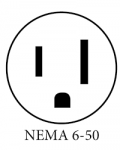250.140 Frames of Ranges and Clothes Dryers. Frames of
electric ranges, wall-mounted ovens, counter-mounted cooking
units, clothes dryers, and outlet or junction boxes that are part
of the circuit for these appliances shall be connected to the
equipment grounding conductor in the manner specified by
250.134 or 250.138.
Exception: For existing branch-circuit installations only where an
equipment grounding conductor is not present in the outlet or junction
box, the frames of electric ranges, wall-mounted ovens, counter-mounted
cooking units, clothes dryers, and outlet or junction boxes that are part
of the circuit for these appliances shall be permitted to be connected to
the grounded circuit conductor if all the following conditions are met.
(1) The supply circuit is 120/240-volt, single-phase, 3-wire; or
208Y/120-volt derived from a 3-phase, 4-wire, wye-connected
system.
(2) The grounded conductor is not smaller than 10 AWG copper or
8 AWG aluminum.
(3) The grounded conductor is insulated, or the grounded conductor
is uninsulated and part of a Type SE service-entrance cable and
the branch circuit originates at the service equipment.
(4) Grounding contacts of receptacles furnished as part of the equipment
are bonded to the equipment.


